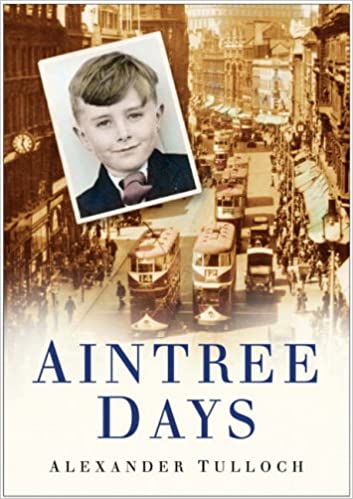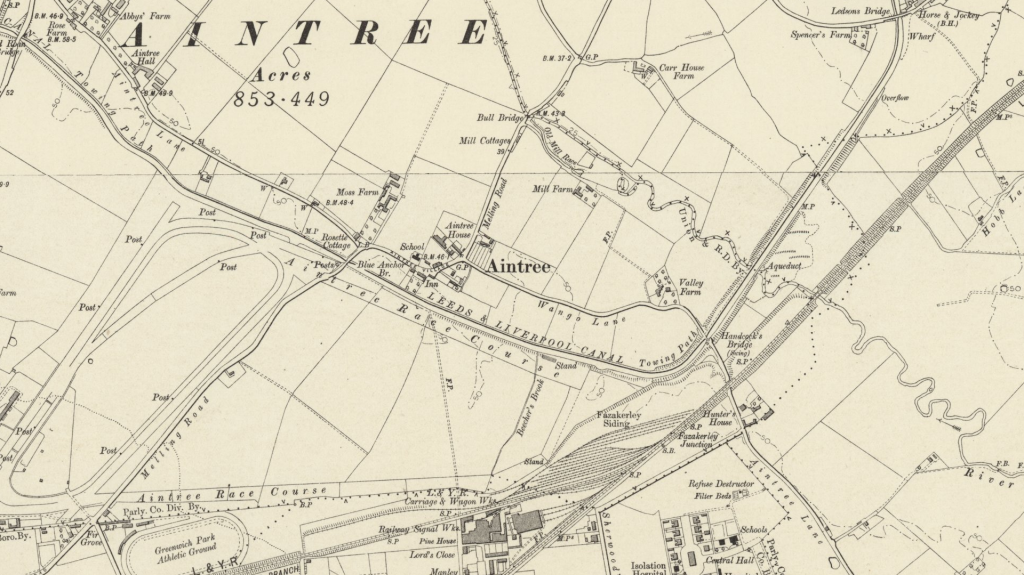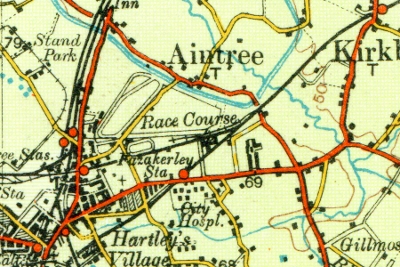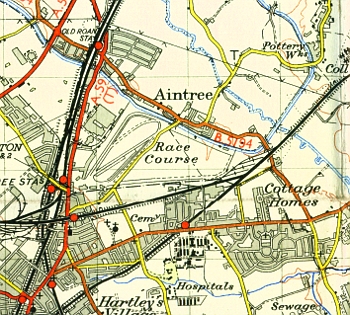Aintree was a tiny rural village until the beginning of the twentieth century. In 1894 the population was only 300 – too small for even a parish council! The first signs of change appeared as industry arrived, as with the opening of the British Enka Artificial Silk factory, when a handful of new houses were built for the factory workers near the Blue Anchor. Three years later houses appeared at the east end of the village, and then more on the main road to Liverpool.

Recommended sources
Website: https://aintreevillageparishcouncil.gov.uk/the-parish/parish-history/ The parish council’s own website has loads of large images and a wealth of information on the history of Aintree.
Book: Aintree Days, by Alexander Tulloch. There are few books on Aintree history that don’t talk exclusively about racing of one sort or another, but given Alexander Tulloch’s other books on Liverpool, this should be a good read.
Aintree as a village
Use the slider in the top left to change the transparency of the old map.
Tiny Beginnings, Industrial Expansion
Aintree’s great advantages for industry are its landscape and location. Factories could expand across the flat open land, attracting more and more workers. Housing could be built in huge chunks so workers could live close by. Products from the factories moved quickly to Liverpool and its docks. Even the military realised the possibilities, and sited one of the Royal Ordnance Factories here in the 1930s.
So from the late 19th century until to the Second World War, Aintree expanded at a phenomenal rate. In the later twentieth century, more ‘clean air’ industries joined the growth. Food processing, electrical engineering and printing were all close by, along with similar sites growing in Speke. By 1952, 24 factories employed 12,800 people, as part of a post-war move to re-allocate Britain’s industrial resources.
Horses and Cars at Aintree Racecourse
The more recent history of Aintree is inseparable from the racecourse and the Grand National. Horse racing was a popular sport in Liverpool from at least Tudor times. In the 18th century Nicholas Blundell organised races on the sands at Crosby and the Derby was run here in 1780. William Lynn, landlord of the Waterloo Hotel in Aintree, created a racetrack close to his own pub in 1829. In 1836 he opened a new grand stand, and then organised a four mile steeplechase, won that year by Captain Beecher on ‘Duke’. Some researchers prefer to think of this race as the first true Grand National.
By 1839 the aristocracy took an interest, and Lords Derby, Eglington, Wilton and Sefton and Lord George Bentinck backed a national racing event. Fifty thousand people crowded into the event, and so the race was dubbed the ‘Grand National’ by a journalist. The label came into common use, and in 1847 became official.
But it’s not only horses which have raced around Aintree. The British Grand Prix came to Liverpool five times between 1955 and 1962, and in 1953 Stirling Moss became the first Briton to win it. Car racing finally came to an end at Aintree in the early 1980s.
From an acorn ain mighty oak

Domesday Book makes no mention of Aintree. It was a small part of West Derby, and came under that place’s entry.
The flat and featureless place may have gained it the name ‘One Tree [and little else!]’. But once people drained the boggy land and industries moved in, the landscape worked in its favour. The proximity of Liverpool was the perfect way to transport goods to market, and companies flocked to take advantage of the open space and growing workforce.
Aintree is known to racing fans and the wider public for its steeplechase. But for almost as long the village has been the centre of an industrial tradition which carries on today.
Bibliography
- History, Aintree Village Parish Council, retrieved 3rd August 2014
- History of S Giles Church, Parish Church of St. Giles, retrieved 3rd December 2009

